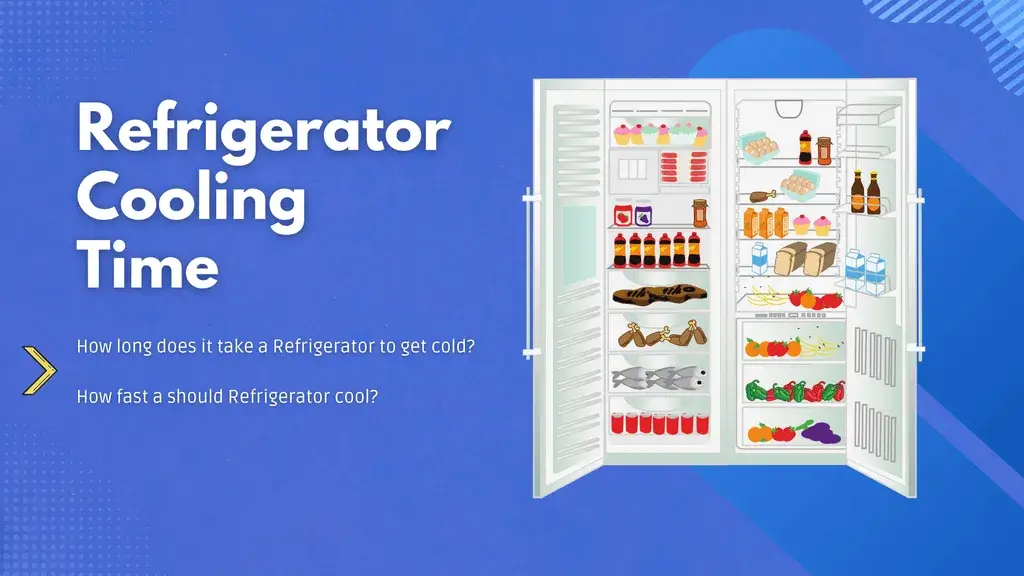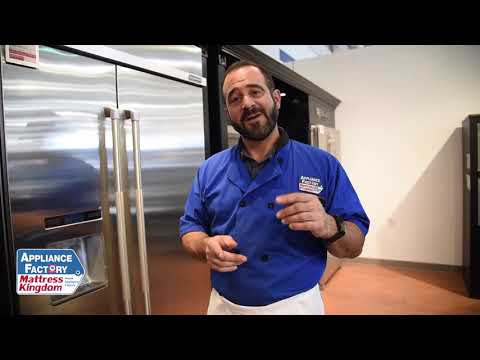Plugging in a new refrigerator can bring about a question, how long does it take for a refrigerator to get cold? Knowing when your refrigerator will start cooling is important for food storage. This guide can help you understand your appliance’s cooling timeline.
Generally refrigerators take around 2-3 hours to get to a temperature of 37°F depending on the initial temperature. Anything below 40°F is considered optimal food storage temperature.
Though how long a fridge can take to get cold depends on several factors, including the make and model of the refrigerator, how large it is, and the weather conditions. This information is essential for homemakers and food enthusiasts to keep food fresh and tasty.
In this article, we’ll look at the different factors of how long it takes to get a refrigerator cold and give you tips on how to speed up the process.
Table Of Contents

How Long Does It Take a Refrigerator to Get Cold?
You might wonder, “How long does it take a fridge to get cold after plugging it in?”
A refrigerator generally takes 3 to 24 hours to hit the set temperature. It may take up to 24 hours if the beginning temperature is 90°F (32°C) to get to the safe storage temperature of 40°F (4°C). However, if the starting temperature is 60°F (15°C), the optimal temperature can be achieved in a few hours.
However, this time can change due to various factors. Let’s look into these factors more closely.
Factors Affecting Cooling Time
- Refrigerator Size and Model: Bigger fridges and different models need varying cooling times.
- Ambient Temperature: High room temperature makes the fridge work harder to cool.
- Food Quantity: Too much food obstructs cold air circulation, increasing cooling time.
What’s the Ideal Temperature?
Wondering about the right refrigerator temperature?
The U.S. Food and Drug Administration (FDA) suggests below 40°F (4°C) for the fridge and 0°F (-18°C) for the freezer.
https://www.fda.gov/consumers/consumer-updates/are-you-storing-food-safely
Note, it’s important to not just reach but maintain these temperatures for food safety. Using a refrigerator thermometer can help keep a consistent safe range.
Quick Tips for Faster Cooling
Need to cool your fridge quickly? Follow these tips:

- Ventilate: Leave enough space around your fridge for efficient cooling.
- Change Temperature Setting: Use maximum cooling setting if available, then return to normal once desired temperature is reached.
- Limit Door Opening: Minimize the number of times you open the fridge to prevent cold air loss.
While a fridge typically takes 24 hours to cool, various factors can alter this. Knowing these can help maintain optimal food storage temperature.
The Role of Refrigerator Type on Cooling Time
Let’s discuss how long it takes for different types of refrigerators to cool. The kind you have significantly impacts the cooling time.
The exact cooling time can depend on many factors including initial and ambient temperatures, and how often the refrigerator door is opened.
It’s best to let your refrigerator reach its ideal temperature before placing food in it for optimal freshness and safety.
Why Is the Location of Your Refrigerator Important in Cooling Time?
Ever thought about how fridge placement affects cooling time? It’s crucial for quick temperature achievement. Let’s explore.
Primarily, fridges work by taking in heat from inside and releasing it outside. They should be in a ventilated space for efficient heat exchange. If the fridge is in a tight spot or between appliances, cooling may be delayed.
Tip: Leave space around the fridge for air circulation. This helps heat disperse efficiently and the fridge to cool faster.
To sum up, the fridge’s location greatly influences its cooling time. Considering these factors can help your fridge reach optimal temperature swiftly.
Why Does a Refrigerator Take Time to Cool Down?
A refrigerator takes time to cool down because it needs to reach a lower temperature than the surrounding air. But still, there are several reasons why it may take a while for the fridge to cool down.
The cold air inside the fridge is heavier than the warm air outside, so it takes time for the air inside it to equalize with the air outside. The refrigerator also has to work harder to cool down the air when you open the door since warm air from outside can enter and raise the temperature inside the fridge.
Some new models do not have cooling coils around the sides of the refrigerator that typically go through cycles faster than older models would. They will heat up and cool down more quickly than refrigerators with similar features.
Another reason why it takes longer is due to regular use on how often you open and close your door and what can be stored inside. Like pop and soda cans, some items require more refrigerator cooling time than other everyday household items.
Experiment by filling different types of objects within your fridge and finding which ones are quickest to coldness than others that use the same energy to get them chilled down.
How to Maximize Refrigerator Cooling Time?
Quick cooling in fridges is fun and will also heat an empty compressor unit for your next refrigeration project with no real financial gain. There are a few ways to speed up the cooling process of your food.
- Make sure the area you’re cooling is as large as possible.
- Reduce the generated amount of heat.
- Increase the airflow.
- Use a fan to help circulate the air.
- Use ice or cold water to help lower the temperature.
- Keep the area well ventilated.
- Open the windows and doors to let in cooler air.
- Turn off any heat-generating appliances.
- Close the curtains or blinds to keep out the heat.
- Press in cool, comfortable clothing.
By following these tips, you should be able to cool food down quickly and efficiently. It will help to cool the food down quickly.
Frequently Asked Questions
The question often asked about refrigerators is – how long does it take for a fridge to cool? The answer varies, but let’s explore some common questions to understand this more.
How Long Does It Take Freezer to Get Cold?
Curious about how long it takes a freezer to cool? The time can vary based on factors like initial freezer temperature, room temperature, and the freezer’s type, size, and power.
Usually, a standalone freezer takes 4 to 12 hours to hit 0 degrees Fahrenheit, while a refrigerator-freezer combo may take 12 to 24 hours.
Why Do You Have to Wait 24 Hours to Plug in a Fridge?
Why should you wait 24 hours before plugging in a new fridge? It’s due to the oil in the compressor, which can move into the cooling lines during transport. Starting the fridge immediately may trap this oil in the lines, impairing the cooling system.
Here’s what happens:
- Transportation: The oil might shift from the compressor into the cooling lines when the fridge is moved.
- Settling Down: If you let the fridge sit for 24 hours, the oil will seep back into the compressor.
- Starting Up: After waiting, starting the fridge will ensure the compressor functions properly with the oil back where it belongs.
Patience is crucial when setting up your fridge. Waiting 24 hours can ensure your fridge cools efficiently for years to come.
How Long Does a Fridge Take to Get Cold After Being Off?
It’s a common question, and one that’s crucial to understand – how long does a fridge take to get cold after being off? Well, the time varies based on several factors, including the model of the refrigerator, the temperature settings, the ambient temperature, and how full it is.
However, as a general rule, you can expect it to take between 3 to 24 hours for a refrigerator to reach its optimal temperature after being off.
Does a Full Fridge Take Longer to Cool?
A full fridge can take longer to cool than a half-full or empty fridge, due to the amount of cold air it can hold.
Can You Use a New Refrigerator Immediately?
A new refrigerator can often be used right away, but a few things to keep in mind. First, make sure the compressor is running, and the freezer is cold.
Second, check for ice buildup on the freezer coils and remove them if you find any. Finally, wipe down the refrigerator’s interior with a clean cloth to remove any fingerprints or other dirt.
How Long Do You Have to Wait Before Putting Food in a New Refrigerator?
The correct answer to this question is zero. If you have just brought a new refrigerator and need to put food in it, don’t wait. You can go ahead and put your food in it now.
To Finish With
We’ve answered the common question: “how long does it take a refrigerator to get cold?”. The answer involves various considerations which we’ve simplified for you.
On average, a refrigerator cools down in 2 to 4 hours. Factors such as the model, size, surrounding temperature, and food quantity affect this time. When moving or setting up a new fridge, allow enough time for optimal cooling.
A well-maintained refrigerator is key to keeping your food fresh and tasty.
Here’s a summary:
- A refrigerator takes around 2 to 4 hours to cool.
- Size, ambient temperature, and food content affect this time.
- Give your refrigerator sufficient time to reach its cooling temperature.
Understanding your refrigerator’s cooling process helps utilize this appliance effectively. Fill it up, and let it keep your food cold and fresh.
